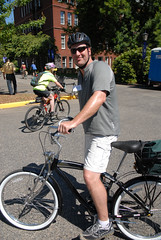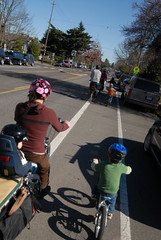
testified that “Our transportation system in this
country is focused on the automobile,
and we’re paying a price for it.”
(Photo: Michael Andersen)
More and more, the suburbs are making big-city bike values their own.
The latest sign: Clark County, Portland’s more auto-oriented neighbor to the north, passed a 20-year, $91 million* bike plan today with votes from two conservative rural Republicans and full-throated support from the chamber of commerce. (*Note: Like Portland’s bike plan, Clark County’s plan is almost completely unfunded at this time.)
Bike facilities will help the Vancouver area, which has Washington’s highest unemployment rate, lure “future knowledge workers, innovators and entrepreneurs,” chamber recruiter Paul Montague told Clark County’s three commissioners Tuesday.

happens to be Chair of the
Clark County commission.
(Photo © J. Maus)
Steve Stuart, the urban Democrat who chairs the commission and won a narrow re-election this month, made another case for bikes: he asked parents at today’s hearing to remember the day their child learned to ride.
“It’s a moment that can’t be replaced in the memory bank: that first moment when you felt your child get that freedom, that rush, on two wheels,” Stuart said.
While the inspiration is similar, a closer look at the details of this new plan shows us that as bike-love spreads to Clark County, they’re not simply following Portland’s tracks; they’re following their own path. Here are five key ways Clark County’s new plan is different than Portland’s:
It’ll rely on the main roads.
Most of the side streets outside central Vancouver simply don’t connect to each other. Major streets are the only way to get around. That means low-traffic bike boulevards, like Portland’s huge North-Northeast-Southeast grid, are out.
If the lack of bike lanes on, say, Southeast Division Street drives you crazy, then Vancouver is going to be your kind of town. As the map on page 39 of the plan shows, huge arteries like Northeast 72nd Avenue, Northwest 119th Street and East Mill Plain Boulevard are all slated to have bike lanes, if they don’t already.
This isn’t because Clark County has made speed a priority. It’s because planners don’t really have a choice. As in most neighborhoods built after 1940 or so, most of the side streets outside central Vancouver simply don’t connect to each other. Major streets are the only way to get around. That means low-traffic bike boulevards, like Portland’s huge North-Northeast-Southeast grid, are out.
It’ll be built for families and recreation first.
Stereotypes aside, Vancouver and Portland families aren’t much different. The average Portland family has 3 people; the average Clark County family has 3.2.
But when it comes to biking, Clark County families have clout – maybe because they aren’t competing for bike earmarks with a Portland-sized population of bike commuters. Of $91 million in priority bike projects identified by the Clark County plan, $80 million would go to multi-use paths already included in local park plans. More than half would go to a single trail along the old Chelatchie Prairie Railroad, from Lake Vancouver to Orchards, Battle Ground and Yacolt.
County bike and pedestrian planner Laurie Lebowsky said better bike recreation paths are badly needed, both to recruit the next generation of bikers and to give young people a place for bike fun.
“I’ve focused on making it something that’s much more focused on families and children,” she said of the county plan. “I’ve volunteered in the schools to educate about bicycle and pedestrian safety. It’s really disheartening to see how little activity they get now.”
It might snake dedicated paths through the cul-de-sacs.
If the auto-intensive subdivisions of the 90s are turning out to be lemons, offroad bikeways might turn out to be the lemonade. The dedicated paths could connect neighborhoods by curving around suburban backyards and plugging directly into main streets.
The catch: Most new subdivisions have tiny backyards ringed by six-foot fences. Those keep the paths out of eyeshot – which can make them perfect hangouts for suburban criminals, who are often teenagers. Lebowsky wants to look into codes that would put a height limit on new fences, for the sake of safety.
“Other jurisdictions I’ve worked in, they’ve required fences that were more neighbor-friendly,” said Lebowsky, who previously worked in Washington county.
It’ll be custom-built to help poor people stay healthy.
When Portland decides where to add a new bikeway or walking path, it doesn’t try to calculate exactly how much it’d affect the neighborhood’s physical health.
“The annual cost to Clark County of obesity and inactivity is $110 million a year. We cut obesity by 10 percent … that would almost pay for all our projects.”
— Laurie Lebowsky, County bike and pedestrian planner
But Clark County, thanks to a proactive public health department and a grant from the Robert Wood Johnson Foundation, hired Brendon Haggerty, a former PSU scholar, to estimate how much every proposed improvement would be likely to boost physical activity by nearby residents – especially poor ones, who tend to have higher obesity rates.
“You walk more if you live in a walkable neighborhood, even if you don’t like walking,” Haggerty said. “It’s not definitive, but I think the research is definitely going in that direction.”
When you’re trying to sell a bike plan to a county commission controlled by two rural Republicans, health-care savings become a powerful argument.
“The annual cost to Clark County of obesity and inactivity is $110 million a year,” Lebowsky said. “We cut obesity by 10 percent … that would almost pay for all our projects.”
It might be paid for by higher taxes or fees.
Here’s Portland’s basic strategy to fund bike improvements: stop improving the car network. When the government doesn’t knock down buildings every year to add more auto lanes, it can use the money for auto alternatives.
Here’s Clark County’s strategy, so far: raise taxes.
The bike plan lists 19 different ways Clark County could raise new money for bikes: a $5 fee on every bike sale, general sales or property tax hikes, a vehicle license fee hike, a gas tax hike. The list goes on. What the plan doesn’t mention is any reform to the county’s expensive road-building standards that assume a new urban building, no matter how human-friendly its neighborhood is, will attract exactly as many bikes and pedestrians as one on the edge of town.
In an interview today, Stuart called such a reform “common sense.” Time will tell.
— This article was written by Michael Andersen, publisher of Portland Afoot. Portland Afoot’s December issue is about Portland’s best crosstown bike routes. BikePortland readers in the metro area can subscribe for $10 a year with coupon code “BikePortland.”


